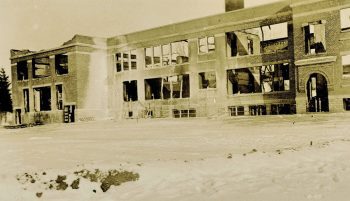
It was a Christmas never to be forgotten by those who experienced it or heard about it from older family members. The temperature was teens below zero, but stationed on every nearby roof to the southeast, people guarded against airborne embers. It was about 10:30 Friday night, December 19, 1924, when on his way home, Owen Onsgard smelled smoke. Several hours after the start of students’ Christmas vacation, the pride of Spring Grove, the new school was on fire.
Dated Christmas Day, the local newspaper headline read, “ENTIRE SCHOOL BUILDING DESTROYED BY FIRE; Firemen and Citizens Join in Losing Fight With Worst Fire in Houston County. Caledonia Department Called, Mercury Way Below Zero.”
The fire department responded quickly, but the first hydrant connected was frozen. Firemen broke into the building and successfully connected a hose. Two streams of water offered hope. The Caledonia Fire Department arrived in good time, too, but the conflagration could not be contained.
At 17 degrees below zero, the water froze and covered many firefighters with ice, some to suffer with frozen ears, toes and noses. A clothing store owner came with a box of mittens for firefighters whose gloves were wet and icy.

Photo by Georgia Rosendahl
Besides those citizens protecting nearby rooftops, other men, women and children entered the burning building and carried out what they could. They saved about half of the library’s 2,000 books and almost all of the equipment in the school office, auditorium and teacher training department. However, the spread of the fire would make it impossible to retrieve everything from the obviously doomed edifice. The standing brick walls retained much of the heat; only a small portion of the brick walls fell.
Across the street from the school was the home of firefighter and school board member Knute Lee and wife Mathilda, whose dining room soon became “packed and stacked” with salvaged items, which would soon also fill the living room and then the porch and then spill onto the snow-covered lawn. The coal stove was stoked as the house became an operations center. Coffee and sandwiches were prepared while women brought in doughnuts and cookies for the firefighters.
Light from the flames was seen as far west as Harmony. Since coal had been recently delivered to school, the remains continued to burn for many days. Although there was not much wind that Friday night, scraps of paper were found on Saturday in Dorchester and Bee. Spring Grove was without water the next day due to the amount of water going into the school overnight. Many who needed a bath were denied for hours as pumps filled the water tower with enough water to provide pressure. The Lee home survived, but there was the lingering smell of charred books, files and ash-laden debris that Mathilda wrote, “permeated our curtains and couches and carpets.”
The source of the fire remained a mystery. It was thought to have started in the middle of the building on the west side. It started just hours following afternoon Christmas parties, where candles may have been present.
It had been only two years since the 1922 construction of an addition and remodeling of the majestic 1899 two-story, brick school building. Six local agents carried insurance on the building and equipment to the amount of $93,300. The building would be restored at a cost of $150,000 and ready for classes the following autumn.
Looking for a silver lining, some pupils looked forward to an extended Christmas vacation, but education resumed on time. Classes were held in various places throughout the community: the Village Hall, Masonic Hall, Lumber Company West office, Glasrud’s Implement Shop, Vick’s new store building and the church basement. The public restroom also helped. Some books, desks and armchairs were quickly ordered to be available when classes resumed on January 5. Later, graduation exercises were held at the opera house.
Alma Hagen, then a high school freshman, recalled having makeshift classrooms all over town. “Wherever there was a room for us. I remember I had an algebra class upstairs at the Arthur Evenson Implement Shop.”
Memories and stories from that catastrophic night and the atypical months of education that followed would linger for generations of Spring Grove families.
Sources: “Spring Grove Herald” (December 25, 1924), “History of Spring Grove” by Sydney Roppe and Blayne Onsgard (1952), “Yesteryears of Spring Grove” (1997), “Mathilda’s Journey,” by Robert E. A. Lee (2000).


Leave a Reply